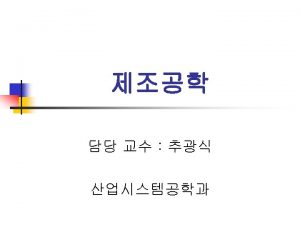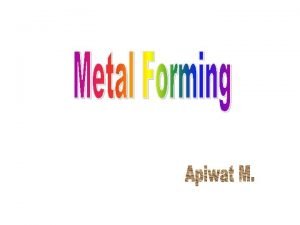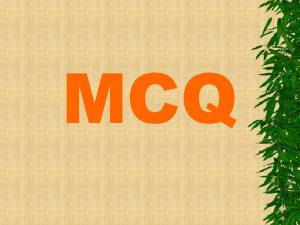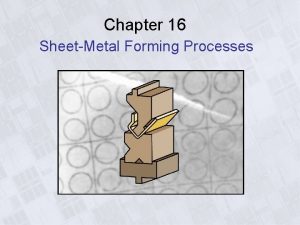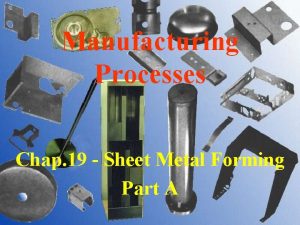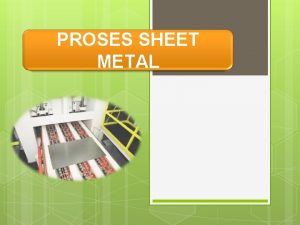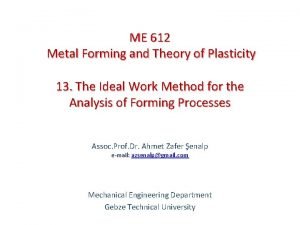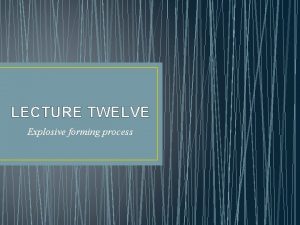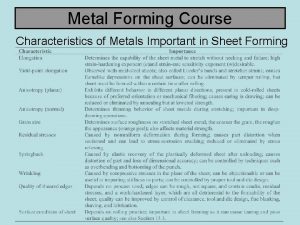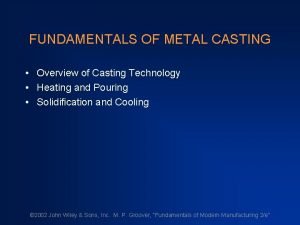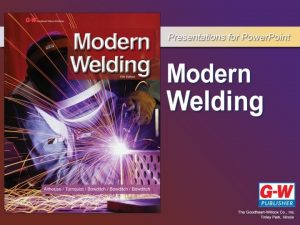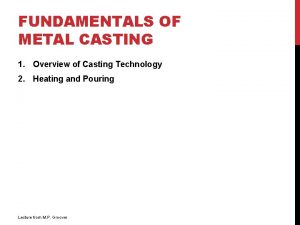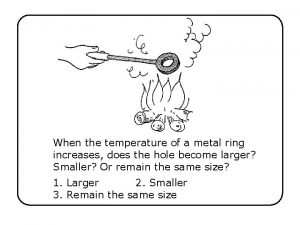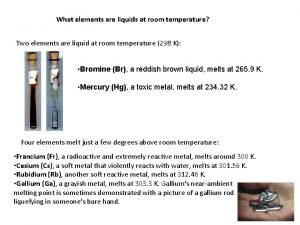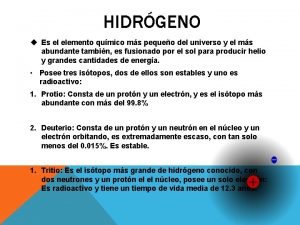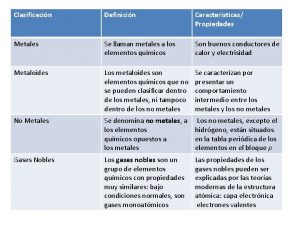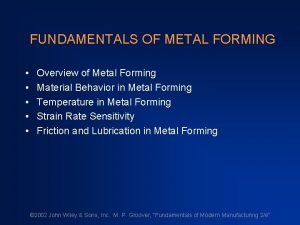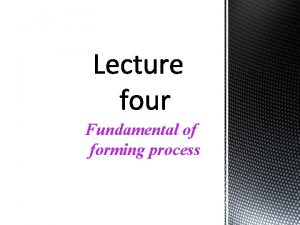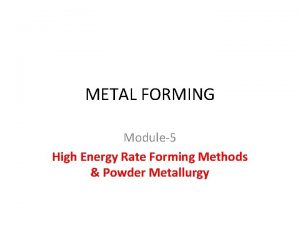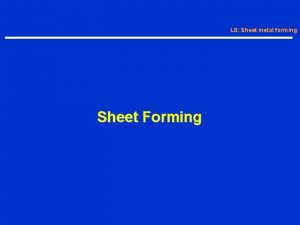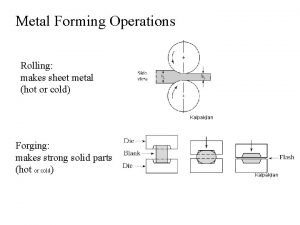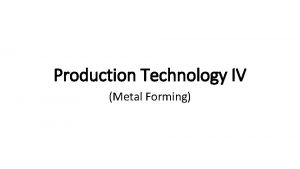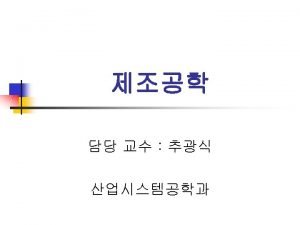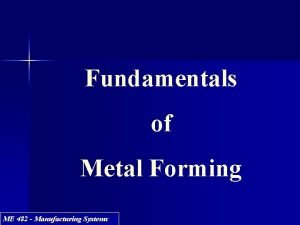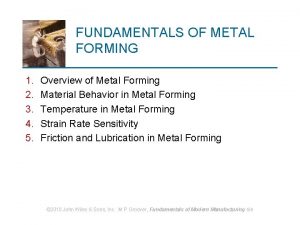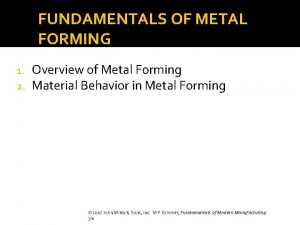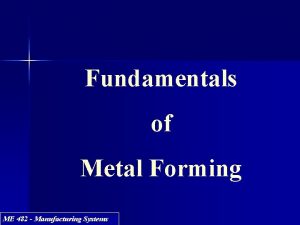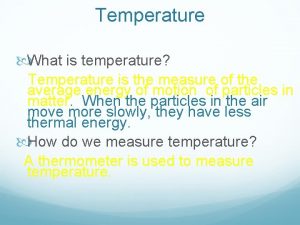FUNDAMENTALS OF METAL FORMING 1 Temperature in Metal






















- Slides: 22

FUNDAMENTALS OF METAL FORMING 1. Temperature in Metal Forming 2. Strain Rate Sensitivity 3. Friction and Lubrication in Metal Forming © 2007 John Wiley & Sons, Inc. M P Groover, Fundamentals of Modern Manufacturing 3/e

• For any metal, K and n in the flow curve depend on temperature • Both strength (K) and strain hardening (n) are reduced at higher temperatures • In addition, ductility is increased at higher temperatures Temperature in Metal Forming © 2007 John Wiley & Sons, Inc. M P Groover, Fundamentals of Modern Manufacturing 3/e

• Any deformation operation can be accomplished with lower forces and power at elevated temperature • Three temperature ranges in metal forming: • Cold working • Warm working • Hot working Temperature in Metal Forming © 2007 John Wiley & Sons, Inc. M P Groover, Fundamentals of Modern Manufacturing 3/e

• Performed at room temperature or slightly above • Many cold forming processes are important mass production operations • Minimum or no machining usually required • These operations are near net shape or net shape processes Cold Working © 2007 John Wiley & Sons, Inc. M P Groover, Fundamentals of Modern Manufacturing 3/e

Advantages of Cold Forming • • Better accuracy, closer tolerances Better surface finish Strain hardening increases strength and hardness Grain flow during deformation cause desirable directional properties in product • No heating of work required © 2007 John Wiley & Sons, Inc. M P Groover, Fundamentals of Modern Manufacturing 3/e

• Higher forces and power required in the deformation operation • Surfaces of starting workpiece must be free of scale and dirt • Ductility and strain hardening limit the amount of forming that can be done • In some cases, metal must be annealed to allow further deformation • In other cases, metal is simply not ductile enough to be cold worked Disadvantages of Cold Forming © 2007 John Wiley & Sons, Inc. M P Groover, Fundamentals of Modern Manufacturing 3/e

• Performed at temperatures above room temperature but below recrystallization temperature • Dividing line between cold working and warm working often expressed in terms of melting point: • 0. 3 Tm, where Tm = melting point (absolute temperature) for metal Warm Working © 2007 John Wiley & Sons, Inc. M P Groover, Fundamentals of Modern Manufacturing 3/e

• Lower forces and power than in cold working • More intricate work geometries possible • Need for annealing may be reduced or eliminated Advantages of Warm Working © 2007 John Wiley & Sons, Inc. M P Groover, Fundamentals of Modern Manufacturing 3/e

• Deformation at temperatures above the recrystallization temperature • Recrystallization temperature = about one‑half of melting point on absolute scale • In practice, hot working usually performed somewhat above 0. 5 Tm • Metal continues to soften as temperature increases above 0. 5 Tm, enhancing advantage of hot working above this level Hot Working © 2007 John Wiley & Sons, Inc. M P Groover, Fundamentals of Modern Manufacturing 3/e

Capability for substantial plastic deformation of the metal ‑ far more than possible with cold working or warm working • Why? • Strength coefficient (K) is substantially less than at room temperature • Strain hardening exponent (n) is zero (theoretically) • Ductility is significantly increased Why Hot Working? © 2007 John Wiley & Sons, Inc. M P Groover, Fundamentals of Modern Manufacturing 3/e

Advantages of Hot Working • Workpart shape can be significantly altered • Lower forces and power required • Metals that usually fracture in cold working can be hot formed • Strength properties of product are generally isotropic • No strengthening of part occurs from work hardening • Advantageous in cases when part is to be subsequently processed by cold forming © 2007 John Wiley & Sons, Inc. M P Groover, Fundamentals of Modern Manufacturing 3/e

• Lower dimensional accuracy • Higher total energy required (due to thermal energy to heat the workpiece) • Work surface oxidation (scale), poorer surface finish • Shorter tool life Disadvantages of Hot Working © 2007 John Wiley & Sons, Inc. M P Groover, Fundamentals of Modern Manufacturing 3/e

• Theoretically, a metal in hot working behaves like a perfectly plastic material, with strain hardening exponent n=0 • The metal should continue to flow at the same flow stress, once that stress is reached • However, an additional phenomenon occurs during deformation, especially at elevated temperatures: Strain rate sensitivity Strain Rate Sensitivity © 2007 John Wiley & Sons, Inc. M P Groover, Fundamentals of Modern Manufacturing 3/e

• Strain rate in forming is directly related to speed of deformation v • Deformation speed v = velocity of the ram or other movement of the equipment • Strain rate is defined: where = true strain rate; and h = instantaneous height of workpiece being deformed What is Strain Rate? © 2007 John Wiley & Sons, Inc. M P Groover, Fundamentals of Modern Manufacturing 3/e

• In most practical operations, valuation of strain rate is complicated by • Workpart geometry • Variations in strain rate in different regions of the part • Strain rate can reach 1000 s-1 or more for some metal forming operations Evaluation of Strain Rate © 2007 John Wiley & Sons, Inc. M P Groover, Fundamentals of Modern Manufacturing 3/e

• Flow stress is a function of temperature • At hot working temperatures, flow stress also depends on strain rate • As strain rate increases, resistance to deformation increases • This effect is known as strain‑rate sensitivity Effect of Strain Rate on Flow Stress © 2007 John Wiley & Sons, Inc. M P Groover, Fundamentals of Modern Manufacturing 3/e

where C = strength constant (similar but not equal to strength coefficient in flow curve equation), and m = strain‑rate sensitivity exponent Strain Rate Sensitivity Equation © 2007 John Wiley & Sons, Inc. M P Groover, Fundamentals of Modern Manufacturing 3/e

Effect of Temperature on Flow Stress Figure 18. 6 Effect of temperature on flow stress for a typical metal. The constant C, as indicated by the intersection of each plot with the vertical dashed line at strain rate = 1. 0, decreases, and m (slope of each plot) increases with increasing temperature. © 2007 John Wiley & Sons, Inc. M P Groover, Fundamentals of Modern Manufacturing 3/e

Observations about Strain Rate Sensitivity • Increasing temperature decreases C and increases m • At room temperature, effect of strain rate is almost negligible • Flow curve is a good representation of material behavior • As temperature increases, strain rate becomes increasingly important in determining flow stress © 2007 John Wiley & Sons, Inc. M P Groover, Fundamentals of Modern Manufacturing 3/e

• In most metal forming processes, friction is undesirable: • Metal flow is retarded • Forces and power are increased • Tooling wears faster • Friction and tool wear are more severe in hot working Friction in Metal Forming © 2007 John Wiley & Sons, Inc. M P Groover, Fundamentals of Modern Manufacturing 3/e

• Metalworking lubricants are applied to tool‑work interface in many forming operations to reduce harmful effects of friction • Benefits: • Reduced sticking, forces, power, tool wear • Better surface finish • Removes heat from the tooling Lubrication in Metal Forming © 2007 John Wiley & Sons, Inc. M P Groover, Fundamentals of Modern Manufacturing 3/e

• Type of forming process (rolling, forging, sheet metal drawing, etc. ) • Hot working or cold working • Work material • Chemical reactivity with tool and work metals • Ease of application • Cost Considerations in Choosing a Lubricant © 2007 John Wiley & Sons, Inc. M P Groover, Fundamentals of Modern Manufacturing 3/e
 Metal forming
Metal forming Wholesale sheet metal forming
Wholesale sheet metal forming In a fusion welding process mcq
In a fusion welding process mcq Forming process in sheet metal
Forming process in sheet metal Metal forming part
Metal forming part Sheet metal adalah
Sheet metal adalah Metal forming analysis gtu
Metal forming analysis gtu Advantage of hot working
Advantage of hot working Explosive metal forming
Explosive metal forming Proses metal forming
Proses metal forming Difference between antiferromagnetism and ferrimagnetism
Difference between antiferromagnetism and ferrimagnetism Difference between curie temperature and neel temperature
Difference between curie temperature and neel temperature Difference between curie temperature and neel temperature
Difference between curie temperature and neel temperature Fundamentals of metal casting
Fundamentals of metal casting Chapter 6 shielded metal arc welding
Chapter 6 shielded metal arc welding Fundamentals of metal casting
Fundamentals of metal casting When the temperature of a metal ring increases
When the temperature of a metal ring increases 2 elements that are liquid at room temperature
2 elements that are liquid at room temperature Blanch def
Blanch def El sodio es metal o no metal
El sodio es metal o no metal Difference between metal oxides and non metal oxides
Difference between metal oxides and non metal oxides Is sulfer a metal nonmetal or metalloid
Is sulfer a metal nonmetal or metalloid Metales y no metales
Metales y no metales
